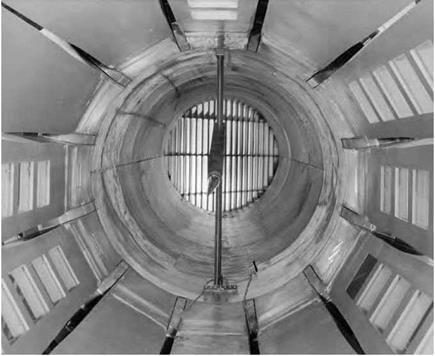Dick Whitcomb and the Transonic-Supersonic Breakthrough
Whitcomb joined the research community at Langley in 1943 as a member of Stack’s Transonic Aerodynamics Branch working in the 8-foot High-Speed Tunnel (HST). Initially, NACA managers placed him in the Flight Instrument Research Division, but Whitcomb’s force of personality ensured that he would be working directly on problems related to aircraft design. As many of his colleagues and historians would attest, Whitcomb quickly became known for an analytical ability rooted in mathematics, instinct, and aesthetics.[145]
In 1945, Langley increased the power of the 8-foot HST to generate Mach 0.95 speeds, and Whitcomb was becoming increasingly familiar with transonic aerodynamics, which helped him in his developing investigation into the design of supersonic aircraft. The onset of drag created by shock waves at transonic speeds was the primary challenge. John Stack, Ezra Kotcher, and Lawrence D. Bell proved that breaking the sound barrier was possible when Chuck Yeager flew the Bell X-1 to Mach 1.06 (700 mph) on October 14, 1947. Designed in the style of a.50- caliber bullet with straight wings, the Bell X-1 was a successful supersonic airplane, but it was a rocket-powered research airplane designed specifically for and limited to that purpose. The X-1 would not offer designers the shape of future supersonic airplanes. Operational turbojet – powered aircraft designed for military missions were much heavier and would use up much of their fuel gradually accelerating toward Mach 1 to lessen transonic drag.[146] The key was to get operation aircraft through the transonic regime, which ranged from Mach 0.9 to Mach 1.1.
A very small body of transonic research existed when Whitcomb undertook his investigation. British researchers W. T. Lord of the Royal Aeronautical Establishment and G. N. Ward of the University of Manchester and American Wallace D. Hayes attempted to solve the problem of transonic drag through mathematical analyses shortly after World War II in 1946. These studies generated mathematical symbols that did not lend themselves to the design and shape of transonic and supersonic aircraft.[147]
Whitcomb’s analysis of available data generated by the NACA in ground and free-flight tests led him to submit a proposal for testing swept wing and fuselage combinations in the 8-foot HST in July 1948. There had been some success in delaying transonic drag by addressing the relationship between wing sweep and fuselage shape. Whitcomb believed that careful attention to arrangement and shape of the wing and fuselage would result in their counteracting each other. His goal was to reach a milestone in supersonic aircraft design. The tests, conducted from late 1949 to early 1950, revealed no significant decrease in drag at high subsonic (Mach 0.95) and low supersonic (Mach 1.2) speeds. The wing-fuselage combinations actually generated higher drag than their individual values combined. Whitcomb was at an impasse and realized he needed to refocus on learning more about the fundamental nature of transonic airflow.[148]
Just before Whitcomb had submitted his proposal for his wind tunnel tests, John Stack ordered the conversion of the 8-foot HST in the spring of 1948 to a slotted throat to enable research in the transonic regime. In theory, slots in the tunnel’s test section, or throat, would enable smooth operation at very high subsonic speeds and at low supersonic speeds. The initial conversion was not satisfactory because of uneven flow. Whitcomb and his colleagues, physicist Ray Wright and engineer Virgil S. Ritchie, hand-shaped the slots based on their visualization of smooth transonic flow. They also worked directly with Langley woodworkers to design and fabricate a channel at the downstream end of the test section that reintroduced air that traveled through the slots. Their painstaking work led to the inauguration of transonic operations within the 8-foot HST 7 months later, on October 6, 1950.[149] Whitcomb,
|
The slotted-throat test section of the 8-foot High-Speed Tunnel. NASA. |
as a young engineer, was helping to refine a tunnel configuration that was going to allow him to realize his potential as a visionary experimental aeronautical engineer.
The NACA distributed a confidential report on the new tunnel during the fall of 1948, which was distributed to the military services and select manufacturers. By the following spring, rumors had been circulating about the new tunnel throughout the industry. Initially, the call for secrecy evolved into outright public acknowledgement of the NACAs new transonic tunnels (including the 16-foot HST) with the awarding of the 1951 Collier Trophy to John Stack and 19 of his associates at Langley for the slotted wall. The Collier Trophy specifically recognized the importance of a research tool, which was a first in the 40-year history of the award. The NACA claimed that its slotted-throat transonic tunnels gave the United States a 2-year lead in the design of supersonic military aircraft.[150]
With the availability of the 8-foot HST and its slotted throat, the combined use of previously available wind tunnel components—the tunnel balance, pressure orifice, tuft surveys, and schlieren photographs—resulted in a new theoretical understanding of transonic drag. The schlieren photographs revealed three shock waves at transonic speeds. One was the familiar shock wave that formed at the nose of an aircraft as it pushed forward through the air. The other two were, according to Whitcomb, "fascinating new types” of shock waves never before observed, in which the fuselage and wings met and at the trailing edge of the wing. These shocks contributed to a new understanding that transonic drag was much larger in proportion to the size of the fuselage and wing than previously believed. Whitcomb speculated that these new shock waves were the cause of transonic drag.[151]











